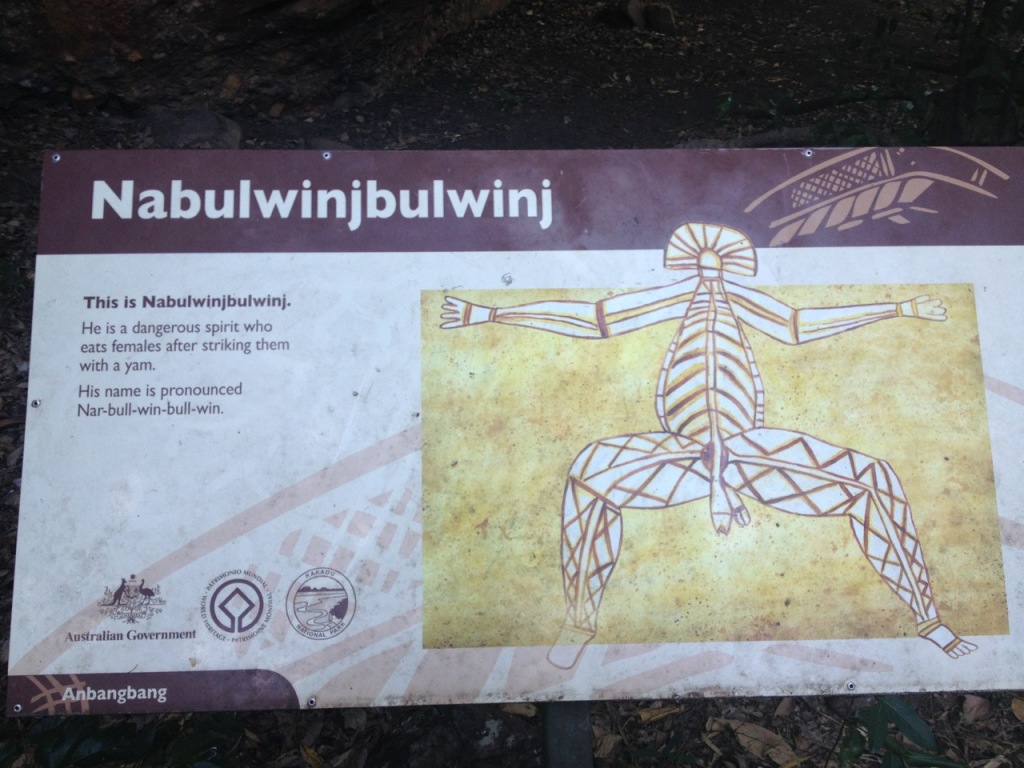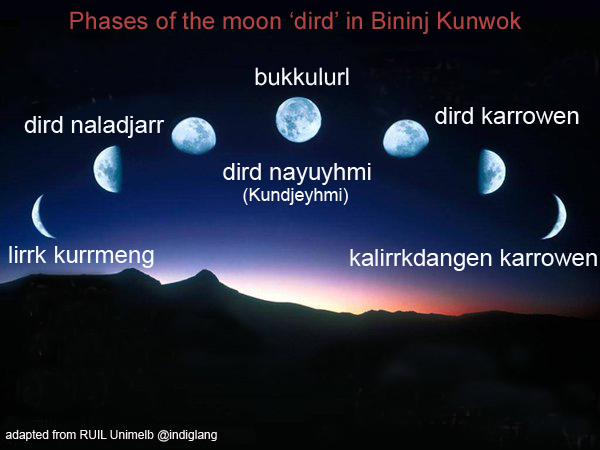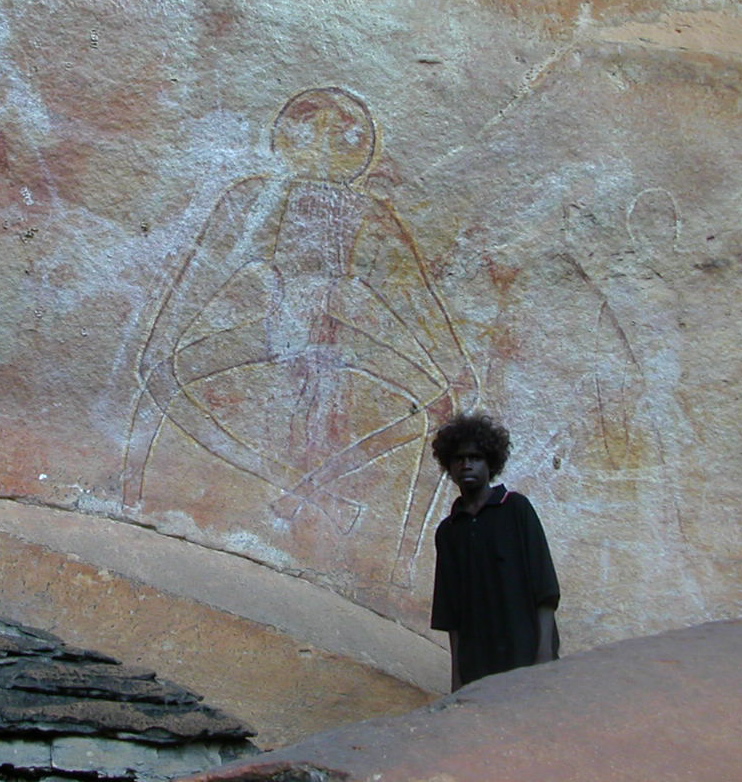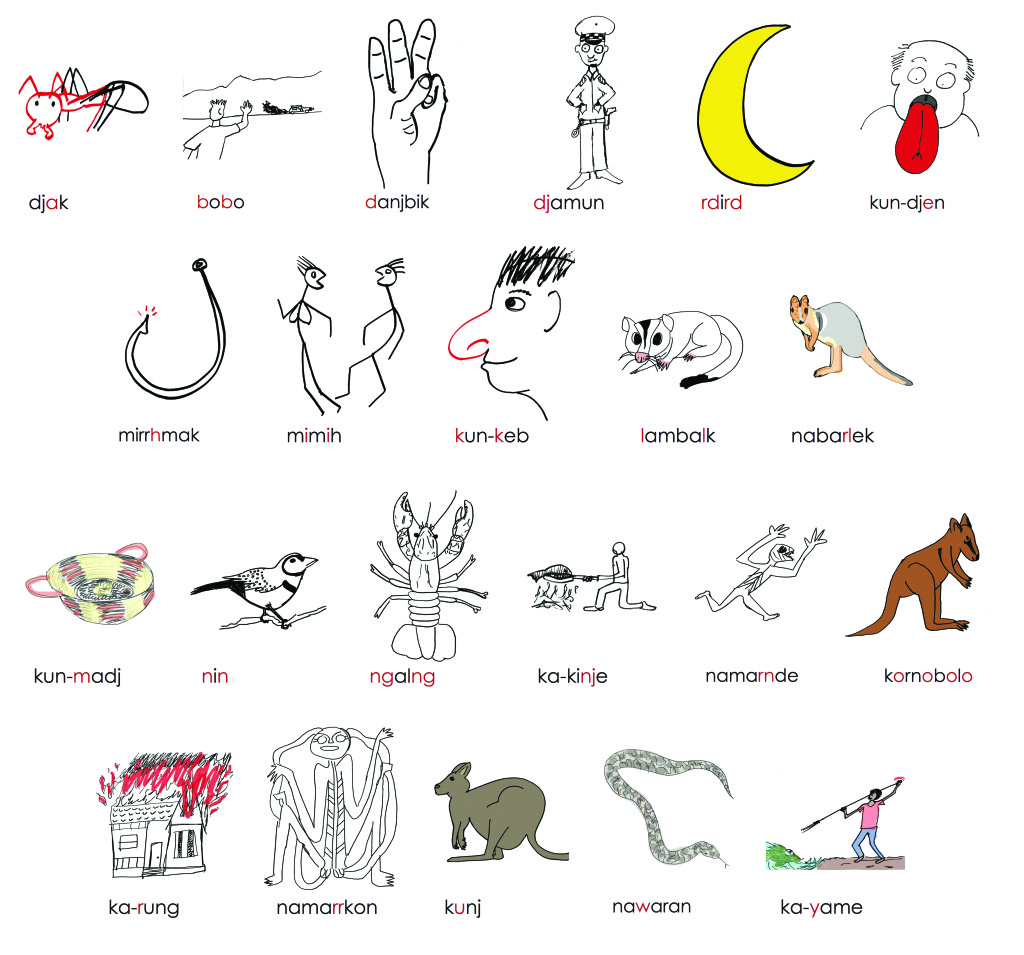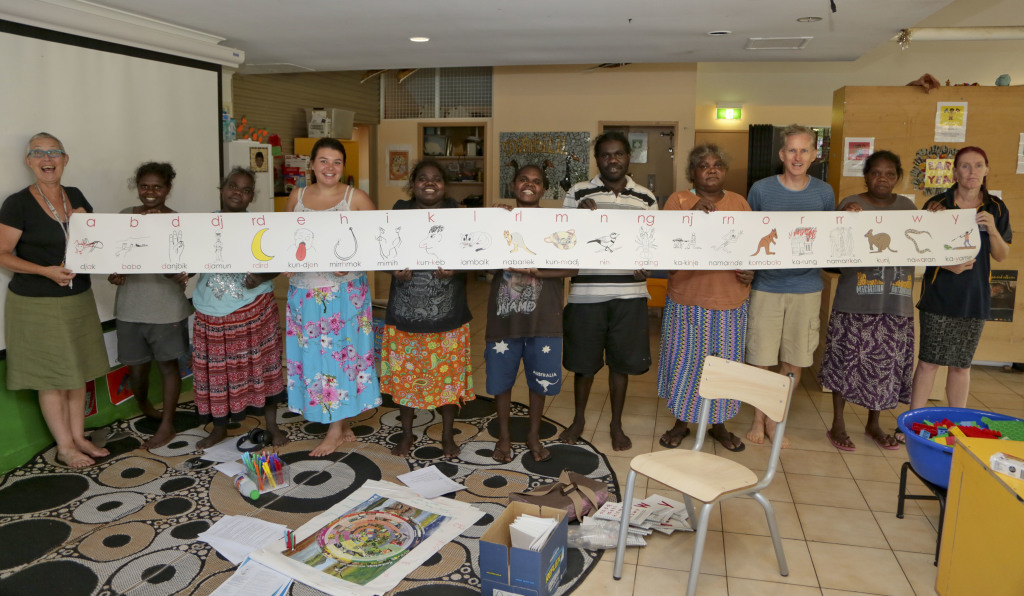Pronunciation guides on signage
Dird 'the moon'
The Research Unit for Indigenous Languages at the University of Melbourne recently tweeted a nice graphic with various names for the moon in a number of Australian Indigenous languages. Here is their same graphic background reworked with names for phases of the moon in Bininj Kunwok:
In Bininj Kunwok dialects ome people call the moon dird and some say karrakbarl. There is an important story about the moon involving two characters, the moon and the quoll. In their human forms in the creation period or 'the dreaming' as some English speakers call it, they both fought over the fate of humanity. The quoll said that when people die, they should die forever and not return to earth but the moon disagreed. As they could not resolve their differences, the moon said he would leave the earth and live in the sky where he could live through a monthly cycle, die, and then return again for another cycle. The quoll stayed on earth and introduced death and so now all humans die but the moon is reborn each month. This is why a waning moon is said to be 'dying' or dird karrowen [moon it-dies] in Bininj Kunwok. In sign language, the hand sign for the quoll is the same as that used for wayarra 'spirit of a dead person' or 'death'. A beautiful and famous image of the moon spirit with his long arms and long penis is depicted at Ngalurdbirrhmi. The picture below depicts this image with Obed Wurrkkidj standing in front.
Obed Wurrkkidj at Ngalurdbirrhmi. © Bininj Kunwok Language Project
The most noticeable difference between English and Bininj Kunwok terms for phases concerns the new moon. A new moon in English is announced before any crescent is visible, i.e. on the night when the whole moon in dark. In Bininj Kunwok the very first thin crescent is called lirrk and when that first thin crescent does appear it is said that 'it [the moon] has put lirrk [the first crescent]'. The opposite term, when the last waning crescent is visible, the term is:
kalirrkdangen karrowen 'the crescent stands and is dying'
ka-lirrk-dangen ka-rrowe-n
it-crescent-stands it-die-non-past
The full moon is called either bukkulurl or dird nayuyhmi.
The word for moon is also the word for month, these two concepts being closely related or the same word in many languages of the world.
You can hear the pronunciation of the word dird by clicking here.
Bonj
That is all.
New Bininj Kunwok Alphabet Chart
We are happy to launch new literacy resources. The first is our alphabet chart and phonics books. These feature illustrations by 15 year old Corben Nabanardi from Jabiru.
Or if you prefer it in compact layout:
The alphabet strip is available for classrooms and community language teaching groups in the Kakadu and Western Arnhem Land region. Each letter of the Bininj Kunwok alphabet is used in a word. Here's the alphabet:
a b d dj rd e h i k l rl m n ng nj rn o r rr u w y
Bininj Kunwok alphabet chart. (L > R) Julie Beer, Martina Balmana, Kaylene Djandjomerr, Shannon McLeod, Kestianna Djandjomerr, Christianna Djandjomerr, Marcus Dempsey, Annie Cameron, Murray Garde, Sonya Nango and Dion Hietmann kabirri-karrme Bininj Kunwok alphabet chart. (bim: Dominic O'Brien)
Bonj
That is all.
Karri-djendukkarren
Karri-djendukkarren
Tongue-twisters
The Resource Network for Linguistic Diversity has been posting some great Australian language tongue-twisters recently. Here is a selection from across the country. Sometimes the texts are also given in the International Phonetic Alphabet as well as a practical community spelling:
A tongue-twister from Bininj Kunwok (Kuninjku dialect):
ngangangh-ngangangh ʼngehngehʼ yimeng
(ŋaŋaŋʔŋaŋa ŋɛʔŋɛʔ yimeŋ)
The grey-crowned babbler said nge’ nge’.
and another favourite:
Dabborrabbolk birribidbom bembem birribimbom.
dabːorabːolk bɪrɪbitbom bembem bɪrɪbɪmbom
'The old people climbed up and painted a sole fish.'
--Murray Garde
From: Burarra/Gun-nartpa
rrugurrgurda jin-digigirrnga
'the crab crawls around'
--Margaret Carew
Here are some Lardil ones:
Dubuduburr durathur dulbiribiriwu burururu.
(ɖubudubur ɖuɹaðuɹ ɖulbiɹibiɹiwu buɹuɹuɹu)
'The tiger mullet will tickle the rain bird with a (species of bush used for firedrill)'
Burbur bana buribur bana burdu.
(buɹbuɹ bana buɹibuɹ bana buɖu)
'Both the feather and the gun are short'
Dulbiribiri dulburri burrurri.
(ɖulbiɹibiɹi ɖulburi bururi)
'The rain bird picked seaweed up off the ground'
--Norvin Richards
Murrinhpatha
I’m loving these tongue twisters! My students always struggle with this
one when learning Murrinhpatha - it’s a good test for the initial velar
nasals.
ngunungam-ngem ngarra Kungarlbarl
‘I’m going to Kungarlbarl’.
Cheers,
--Rachel Nordlinger
bonj
that is all
Yi-djenmarnburren ba yi-wernhwokdi
Yi-djenmarnburren ba yi-wernhwokdi.
Organise your tongue so you can speak properly!
In a recent lesson we looked at the various sounds of Bininj Gunwok and the letters used to represent them. In this lesson we will look at some of the combinations of sounds including what are known as double stops, and combinations of two vowel sounds (or a vowel and a glide such as y or w) known as diphthongs.
Double stops
You will notice that some of the words listed in previous lessons had double letters as in:
dedded red-collared.lorikeet dedded
gukku (KW= kukku) water gukku
ngabbard father ngabbard
These double stop sounds only appear in the middle of words. They can never appear at the start or end of a word. This is because they straddle a syllable boundary and effectively the first of the two consonants closes off one syllable and the second commences the next one. When you pronounce these words you need to clearly articulate each of the two stops. All of the stop consonsants in Bininj Gunwok can be doubled:
bb, dd, rdd, djdj, kk
The retroflex sound rd when it is doubled is usually just written rdd. Here are some examples of each double stop:
nganabbarru buffalo nganabbarru
dabbarrabbolk ancestors, elderly people dabbarrabbolk
bedda them bedda
gaddum (KW= kaddum) above, up high
dardda younger brother dardda
gun-durddu (KW= kun-durddu) heart
godjdjan (KW= kodjdjan) a skin name godjdjan
yirridjdja a moiety name yirridjdja
gakkak (KW= kakkak) mother’s mother, mother’s mother’s brothers and sisters and converse (e.g. a woman’s daughter’s child) gakkak
bokko type of spear with uniserial barbs bokko
Whilst these double stops usually appear between vowels, there are also 6 consonants that can combine with a long stop:
with rr
lorrkkon hollow log coffin lorrkkon
with r
njarlkkan kind of orchid njarlkkan
with rl
warlkkarra ox-eye herring (Kuninjku dialect) warlkkarra
with l
Balbbun Escarpment near Jim Jim Creek, which is the home of the spirit being Algaihgo Balbbun
gubuldjdjarn in the middle gubuldjdjarn
Diphthongs
Kunwinjku iw, ew, aw, ow, ey, ay, oy, uy
Gun-djeihmi iu, eu, au, ou, ei, ai, oi, ui
These sounds are pronounced exactly the same in Gundjeihmi and in Kunwinjku. They are spelt differently because Gundjeihmi has a different orthography or spelling system to Kunwinjku.
Gundjeihmi / Kunwinjku
iu / iw iw
gun-diu / kun-diw liver gun-diu
eu / ew ew
an-djeuk / man-djewk rain an-djeuk
deudeu / dewdew dollar bird (Eurystomus orientalis) deudeu
au / aw aw
wurdyau / wurdyaw child wurdyaw
bauh / bawh be quiet, shush! bauh
ou / ow ow
an-bouk / man-bowk seasonal swamp an-bouk
rouk / rowk all rouk
ei / ey ey
ba-mei / mey he/she got it ba-mei
na-beiwurd / na-beywurd a man's son or woman's brother's son na-beiwurd
ai / ay ay
maih / mayh meat, animals maih
malaiwi / malaywi tomorrow malaiwi
oi / oy oy
gun-boi termite mound gun-boi
doidoih / doydoyh great grandparent doidoih
ui / uy uy
ba-rui / ruy it got cooked ba-rui
bi-rrui / bi-rruy he/she swore at him/her bi-rrui
Bonj. That is all.
